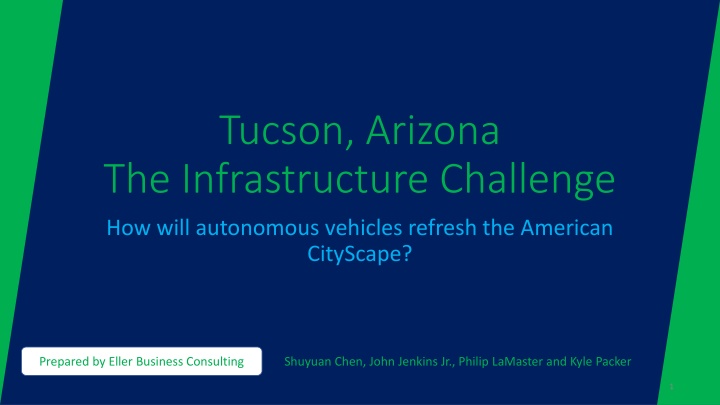
Autonomous Vehicles Transforming Tucson: Infrastructure Challenge
Discover how autonomous vehicles are set to revolutionize Tucson's cityscape, bringing disruptions and opportunities that will impact infrastructure, revenue models, and populations. Explore the challenges and advantages of autonomous vehicles, the concept of Shared Electric Autonomous Vehicles, and the potential impact on the community as American cities prepare for this technological shift.
Download Presentation

Please find below an Image/Link to download the presentation.
The content on the website is provided AS IS for your information and personal use only. It may not be sold, licensed, or shared on other websites without obtaining consent from the author. If you encounter any issues during the download, it is possible that the publisher has removed the file from their server.
You are allowed to download the files provided on this website for personal or commercial use, subject to the condition that they are used lawfully. All files are the property of their respective owners.
The content on the website is provided AS IS for your information and personal use only. It may not be sold, licensed, or shared on other websites without obtaining consent from the author.
E N D
Presentation Transcript
Tucson, Arizona The Infrastructure Challenge How will autonomous vehicles refresh the American CityScape? Prepared by Eller Business Consulting Shuyuan Chen, John Jenkins Jr., Philip LaMaster and Kyle Packer 1
Autonomous vehicles will fundamentally disrupt the operations of city governments across the United States, transforming infrastructure, revenue models and populations. 2
Agenda What are AVs? What are SAEVs? What challenges do they bring? What advantages do they bring? How can we prepare? 3
Tucson is prime for disruption Tucson has a transient population High tourism revenues Undeveloped downtown core 4
What Are Autonomous Vehicles? L1: No Automation L2: Some Automation L3: Driver Assistance L4: Mostly Autonomous, occasional intervention L5: Completely Autonomous Autonomous Vehicles expected to be widespread in next 10 years Free time for drivers, improved safety, more utilization of vehicles, improved sustainability What advantages will they bring? 5
What are Shared Electric Autonomous Vehicles? A fleet of SAEVs operated by one provider, and utilized by riders with mobile devices. AVs can cost 2-3x a normal vehicle to manufacture. What will happen to the members of our community employed in transportation? 6
What will be the impact? Every citizen will be impacted by how the city manages this upcoming shift. Impact of Disruption 7 Speed of Disruption
How have American Cities Reacted? Bans on autonomous vehicles Restrictions to certain neighborhoods License and approval regulations Little to no change in infrastructure No changing of department revenue models 8
Benefits for Cities Technology tourism Economic Development Population Mobility Traffic Safety 9
What are the big issues? How do we act as autonomous vehicles gain traction? Shifting Infrastructure demands Funding Issues Unclear legal ramifications and public perception 10
What can we do about it? Shifting Infrastructure demands Redesign spaces for fewer parking spaces, but more functionality Shift funding from gas, parking, and tickets to fleet operators through licensing Funding Issues Unclear legal ramifications and public perception Maintain transparency with public; engage other governments (State and Federal) as possible. 11
What does this future look like? No loss of revenue as change occurs Improved city center economic development Population buy-in as AVs prove themselves Proper assignation of costs of road usage and liabilities. 12
Conclusion Shifting Infrastructure demands Redesign spaces for fewer parking spaces, but more functionality Shift funding from gas, parking, and tickets to fleet operators through licensing Funding Issues Unclear legal ramifications and public perception Maintain transparency with public; engage other governments (State and Federal) as possible. 13
